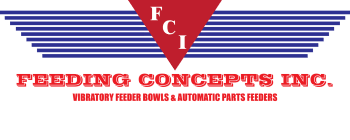It is very important not to overlook the material part contact surface of a feeder. In older days the industry once used cast iron and cast aluminum for the bowl construction. Through years of hard use feeder companies began to see significant wear using these materials. The metal-on-metal contact caused friction which is why those materials did not hold up very well. That is why all of our FCI builders only build with 304 and 316 Stainless Steel. The wear strength and hardness of stainless steel makes it a perfect choice for any feeding project. It is a hard-enough material to trust in the field, but also still has the flexibility to be re-worked and repaired.
Using stainless steel construction on a vibratory feeder improves the overall life of the tooling setup and basic bowl features. Some applications such as food and pharmaceutical parts feeders can benefit from this finish as well. Keeping our system rigid and reliable is our main goal for any project that leaves our doors. That is why we elect to use stainless steel and heat-treated steel inserts on all of our feeders so they can perform well in the field after constant use.
If you have a really abrasive part, you can elect to coat your bowl feeder in polyurethane or Rhino LINE-X liner coating. The Line-X coating is the same coating that storm chasers use on their vehicles when driving through the eye of a tornado. Unlike polyurethane it is virtually bullet proof and has worked coast to coast on many truck beds you see today. The addition of any coating on your feeder gives you the added wear protection and assurance. In the event that the parts do wear through the coating it is unlikely they will wear through the stainless-steel sidewalls and tracks. If that were to ever occur, we could burn out the old coating, sandblast, and then recoat with a new coating.
Check out some of stainless steel vibratory feeder bowls on our YouTube page today!

